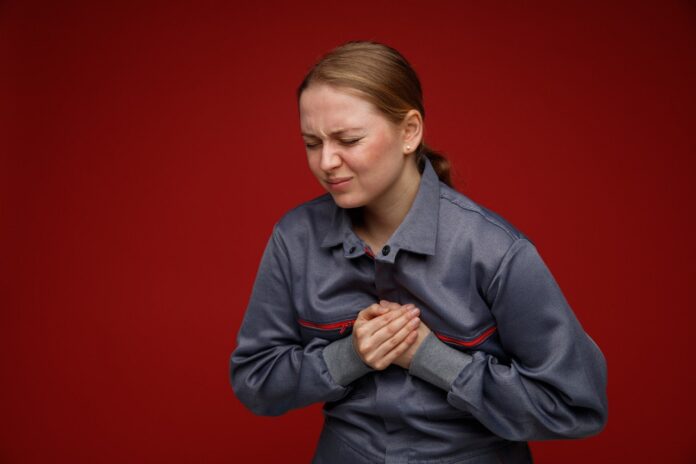According to a new study presented today at Heart Failure 2023, a scientific congress of the European Society of Cardiology (ESC), Women are more than twice as likely to die from a heart attack than men.
“Women of all ages who experience a myocardial infarction are at particularly high risk of a poor prognosis.” said study author Dr. Mariana Martinho of Hospital Garcia de Orta, Almada, Portugal.
She said, “These women need regular monitoring after their heart event, strict control of blood pressure, cholesterol levels, and diabetes, and referral to cardiac rehabilitation. Smoking levels are rising in young women, and this should be tackled, along with promoting physical activity and healthy living.”
Due to their older age, higher prevalence of other conditions, and lower use of stents (percutaneous coronary intervention; PCI) to open blocked arteries, women with ST-elevation myocardial infarction (STEMI) have a worse prognosis during their hospital stay than men.
This study examined whether there were any sex differences in both premenopausal (55 years and under) and postmenopausal (over 55) women’s short- and long-term outcomes following STEMI.
In this retrospective observational analysis, STEMI patients who received PCI within 48 hours of symptom start and were consecutively admitted between 2010 and 2015 were included.
All-cause mortality of 30 days, all-cause mortality of 5 years, and major adverse cardiovascular events (MACE; a composite of all-cause death, reinfarction, hospitalization for heart failure, and ischemic stroke) of 5 years were considered unfavorable outcomes.
There were 884 patients in the research. There were 27% women and a 62-year-old average age. Women reported a higher incidence of high blood pressure, diabetes, and past strokes than males (average age 67 vs. 60 years).
Smoking and coronary artery disease were more prevalent among men. Overall, there was no difference between experiencing symptoms and receiving PCI therapy between men and women. However, women under 55 experienced a considerably longer treatment delay (95 vs. 80 minutes) after presenting at the hospital than their male counterparts.
After adjusting for variables that may have an impact on the relationship, such as diabetes, high cholesterol, hypertension, coronary artery disease, heart failure, chronic kidney disease, peripheral artery disease, stroke, and family history of coronary artery disease, the researchers compared the risk of adverse outcomes between women and men.
At 30 days, there had been 11.8% more deaths among women than men, yielding a hazard ratio (HR) 2.76. At five years, 32.1% of women had passed away compared to 16.9% of men (HR 2.33).
More than one-third of women (34.2%) experienced MACE within five years, compared with 19.8% of men (HR 2.10).
Dr. Martinho said: “Women had a two to three times higher likelihood of adverse outcomes than men in the short- and long-term even after adjusting for other conditions and despite receiving PCI within the same timeframe as men.”
The average age was 62 years, and 27% were women. Women were older than men and had greater incidences of high blood pressure, diabetes, and past stroke.
Men were more likely to smoke and have coronary artery disease. The time between symptoms and PCI treatment did not differ between men and women overall, although women aged 55 and under experienced a considerably longer treatment delay after presenting at the hospital than their male counterparts.
The researchers evaluated the risk of poor outcomes between men and women after controlling for potential confounders. At 30 days, 11.8% of women and 4.6% of males had died, yielding a hazard ratio (HR) 2.76. Nearly one-third of women (32.1%) had been killed after five years, compared to 16.9% of males (HR 2.33).
Within five years, more than one-third of women (34.2%) had MACE, compared to 19.8% of men (HR 2.10).
Dr. Martinho stated that women had a two to three times higher risk of bad outcomes than males in the short and long term, even after controlling for other conditions and getting PCI in the same timeframe as men.
The researchers conducted a further analysis in which they matched men and women according to risk factors for cardiovascular disease, including hypertension, diabetes, high cholesterol, and smoking. Adverse outcomes were compared between matched men and women aged 55 years and under and between men and women over 55.
The matched analysis included 435 patients. All unfavorable outcomes measured in matched patients above 55 were more prevalent in women than males.
Within 30 days, 11.3% of women died compared to 3.0% of men, for an HR of 3.85. At five years, one-third of women (32.9%) had been killed versus 15.8% of men (HR 2.35), and more than one-third of women (34.1%) had MACE versus 17.6% of males (HR 2.15). In matched patients aged 55 and under, one in every five women (20.0%) had MACE within five years, compared to 5.8% of males (HR 3.91), whereas there were no differences in all-cause death at 30 days or five years.
Dr. Martinho said: “Postmenopausal women had worse short- and long-term outcomes after myocardial infarction than men of similar age. Premenopausal women had similar short-term mortality but a poorer prognosis in the long term compared with their male counterparts. While our study did not examine the reasons for these differences, atypical symptoms of myocardial infarction in women and genetic predisposition may play a role. We did not find any differences in the use of medications to lower blood pressure or lipid levels between women and men.”
She concluded: “The findings are another reminder of the need for greater awareness of the risks of heart disease in women. More research is required to understand why there is gender disparity in prognosis after myocardial infarction so that steps can be taken to close the gap in outcomes.”
